Follow Darwin’s journey in the Beagle: study new species and add them to your notebook!
What Is In the Footsteps of Darwin?
In the Footsteps of Darwin is a set-collection game for 2 to 5 players, ages 8 and up, and takes about 30 minutes to play. It retails for $39.99 and is available from Hachette Games or your local game store. The game rules are pretty light and easy to teach to kids, though the actual strategy for scoring well may take a bit of experience (and some math skills). This game is not to be confused with Darwin’s Journey (also released last year), which is a much bigger, heftier game.
In the Footsteps of Darwin was designed by Grégory Grard and Matthieu Verdier and published by Sorry We Are French, with illustrations by Maud Briand and David Sitbon. (It is distributed in the US by Hachette Games, who provided me with a review copy.)
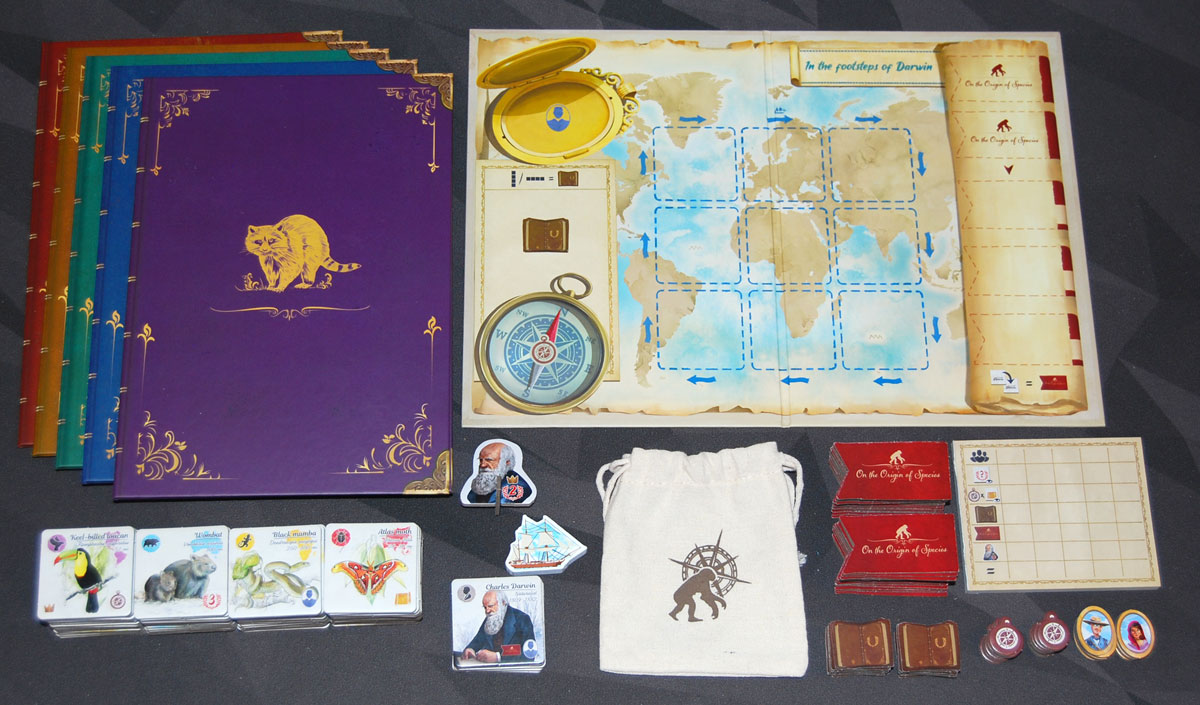
In the Footsteps of Darwin Components
Here’s what comes in the box:
- Journey board
- 5 Naturalist’s notebooks
- 64 Animal tiles
- 5 Character tiles
- 16 Publication tokens
- 15 Compass tokens
- 28 Theory tiles
- 10 Guide tokens
- Darwin token
- Beagle meeple
- Score pad
- Cloth bag
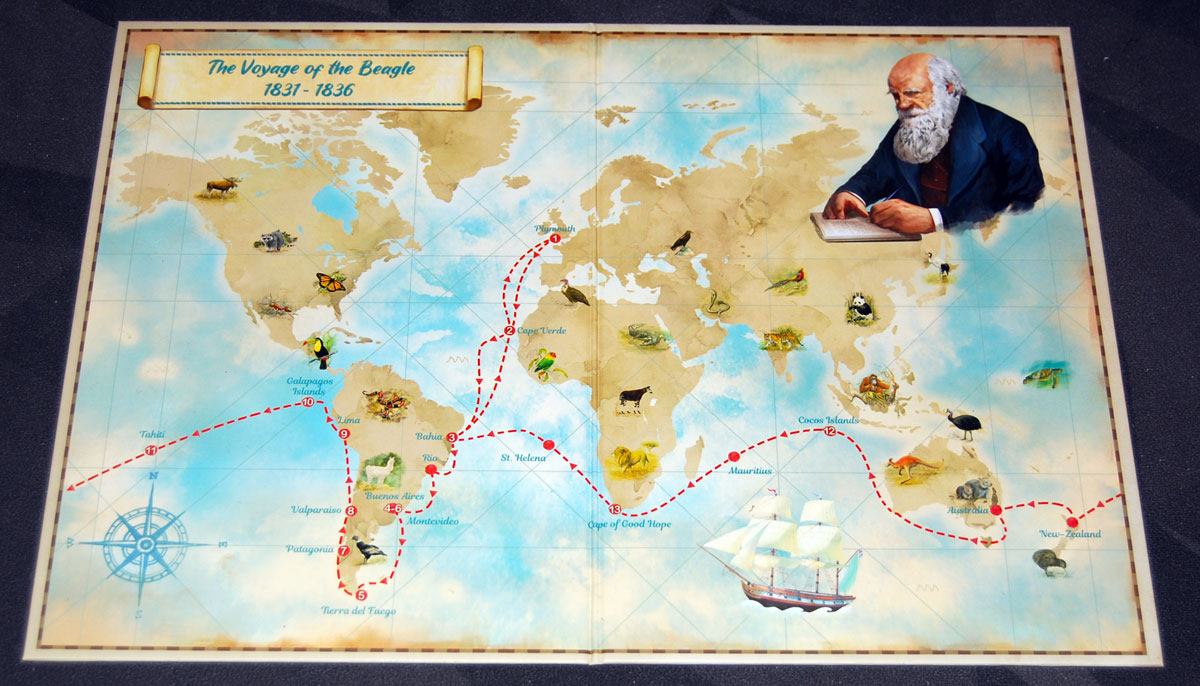
The components in this game are all nice quality and have little touches that give it some extra polish. For instance, the bottom of the box is printed with a world map showing the voyage of the Beagle, which is also printed in a larger size on the back of the journey board.
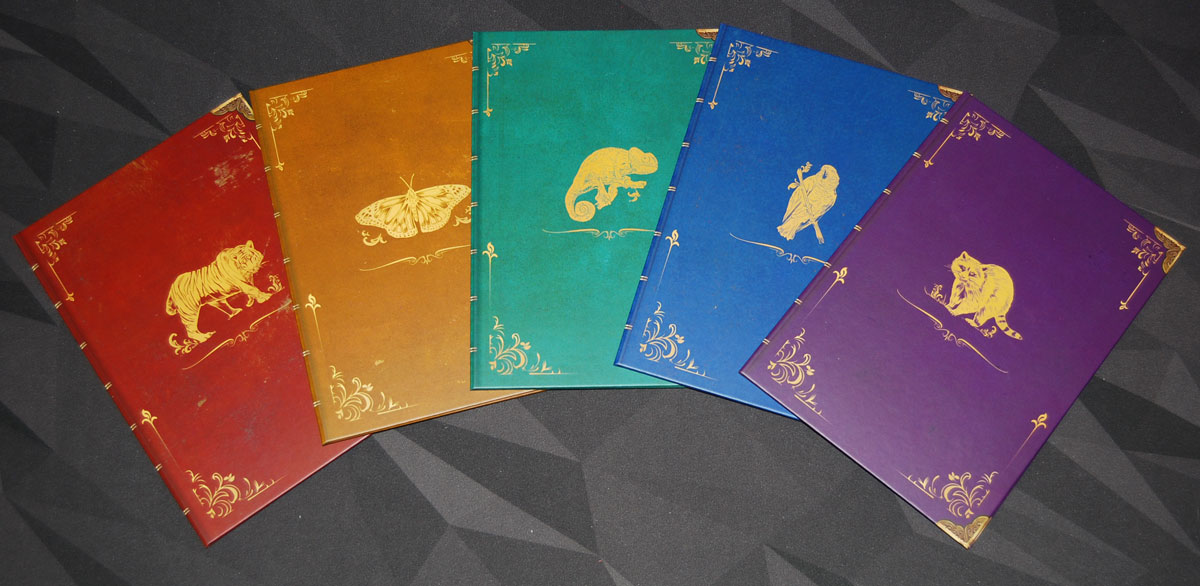
The naturalist’s notebooks are the player boards which fold in half for storage; each one is printed to look like a notebook when closed, with the different animal classes represented on the folders. It’s a lovely bit of art that isn’t actually used for gameplay. The cloth bag is also not a gameplay item—it’s just a nice little bag for storing some of the smaller tokens.
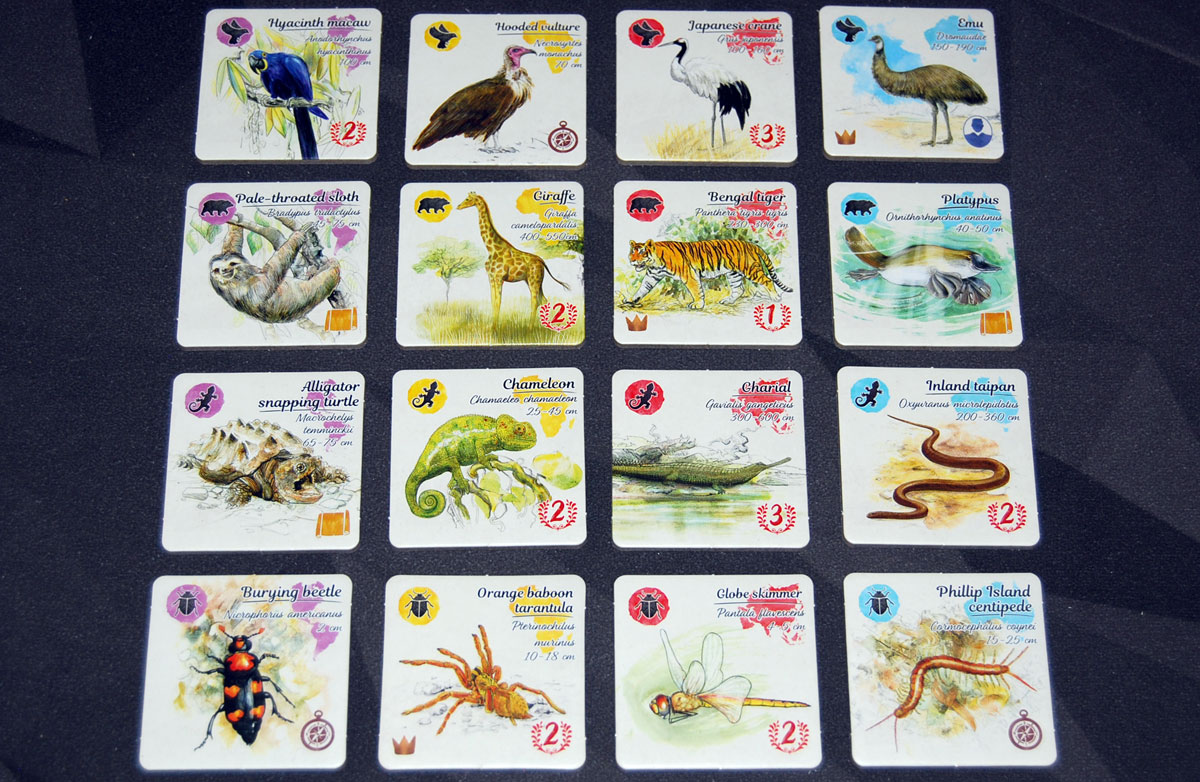
The animal tiles each show an illustration of the animal and provide its English name and its Latin name along with its size, laid over the continent where it is found. There is some additional information—an icon for the class, and things like point values or other icons—but most of the tile is used for the illustration. It’s reminiscent of games like Wingspan, with the feel of something you’d find in a nature handbook.
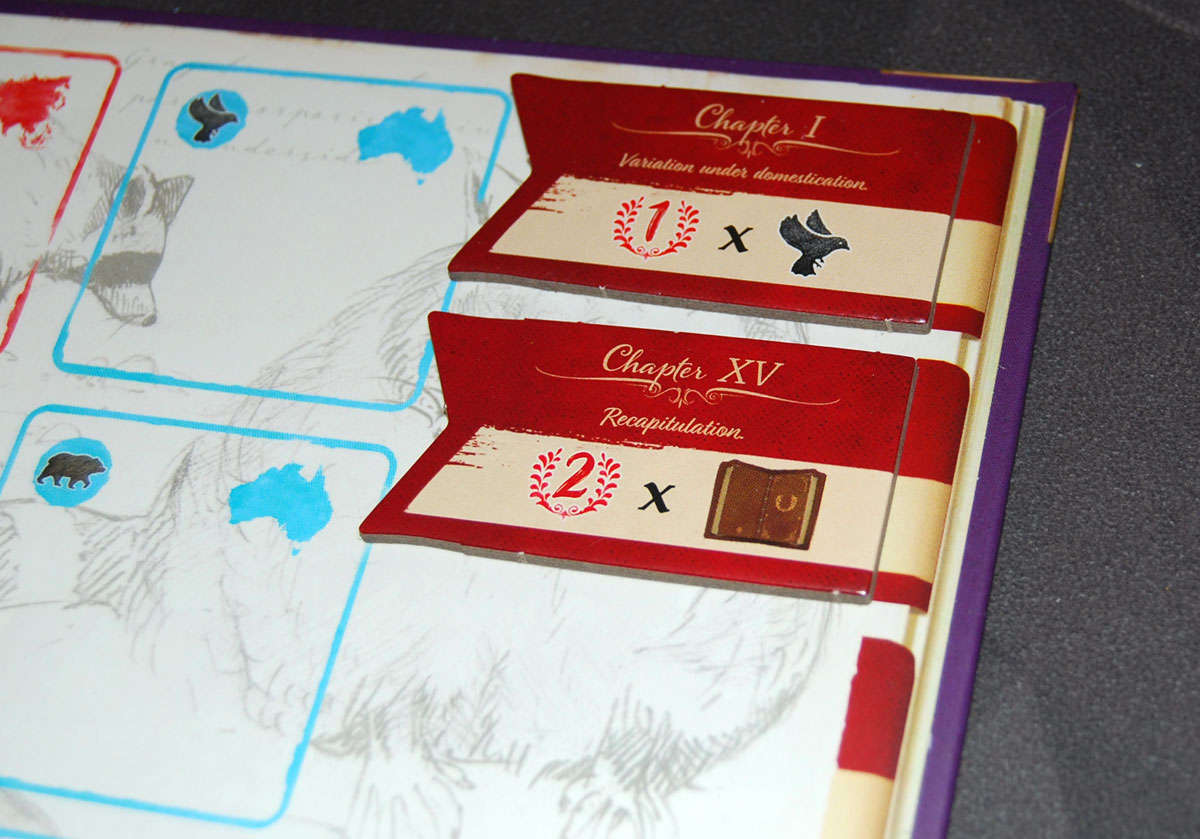
The theory tiles look like notebook ribbons—when placed on the notebook board, they line up with the illustration on the edge to complete the illusion. Each one has a bar showing its scoring rules, and each one is named after a chapter heading from On the Origin of Species. Publication tokens look like little open books with more animal illustrations on them. The guide tokens are made to look like photos in a locket, and depict a variety of people in outfits representing some of the different cultures encountered on Darwin’s journey.
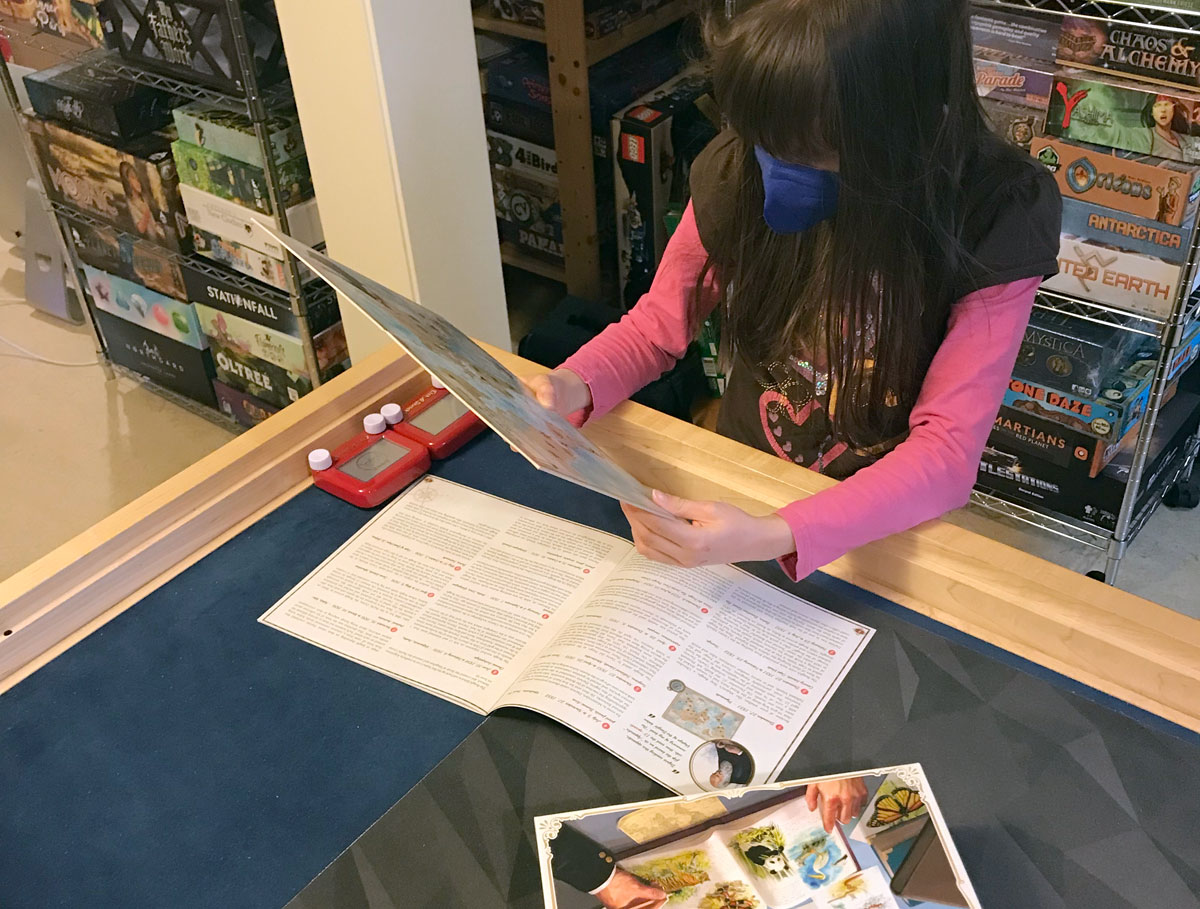
There’s also an appendix, about the same size as the rulebook, that details Darwin’s journey—it uses the map on the back of the journey board to trace his travel and offers a brief travelogue. The rest of the book provides details about all of the species in the game, organized by continent. This is in addition to the hefty two-page spread at the beginning of the rulebook that gives an overview of Charles Darwin, the Beagle, and On the Origin of Species. It’s an impressive amount of information that isn’t required for the game but gives it extra value for use as an educational tool.
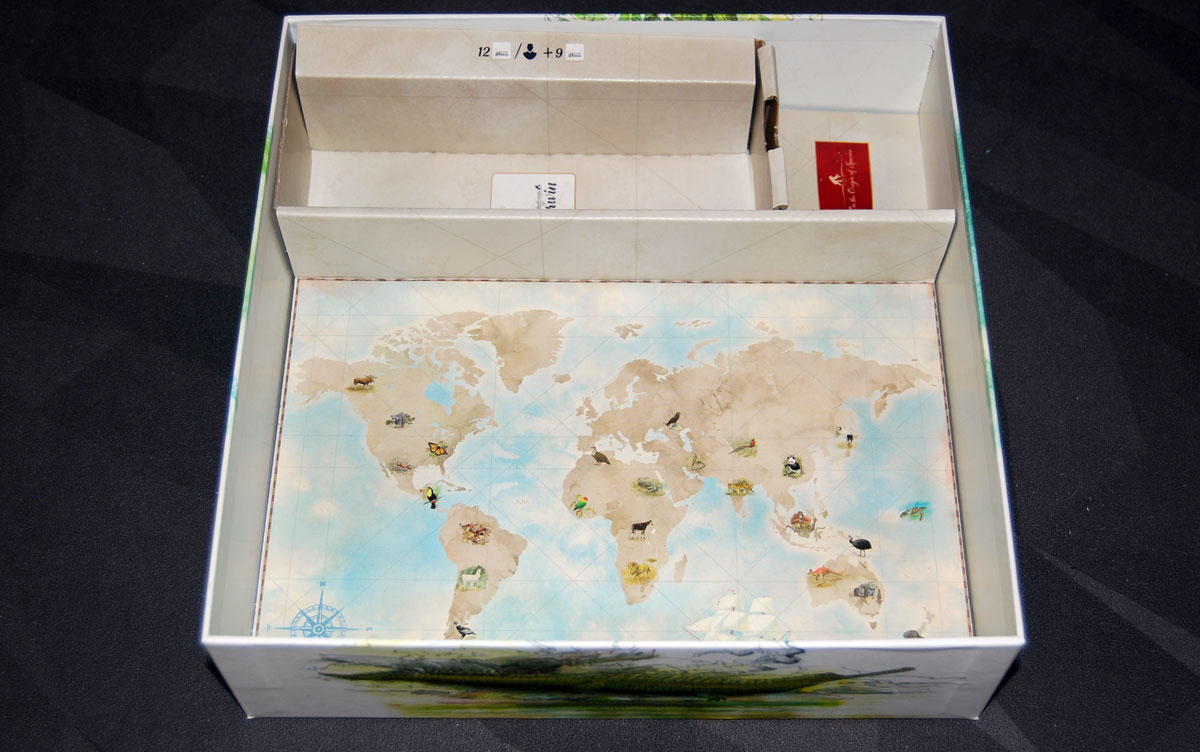
The box insert is a pretty simple cardboard insert, but it’s printed with some details to make it easier to put things away: the journey map I mentioned before for all of the boards, and spaces to show where the various tiles go. One other nice touch: next to the tiles, there’s a reminder of how many tiles you need based on player count, so you don’t have to look that up in the rulebook each time you set up.
How to Play In the Footsteps of Darwin
You can download a copy of the rulebook here.
The Goal
The goal of the game is to score the most points by collecting animal species for your notebook, developing theories, and writing publications.
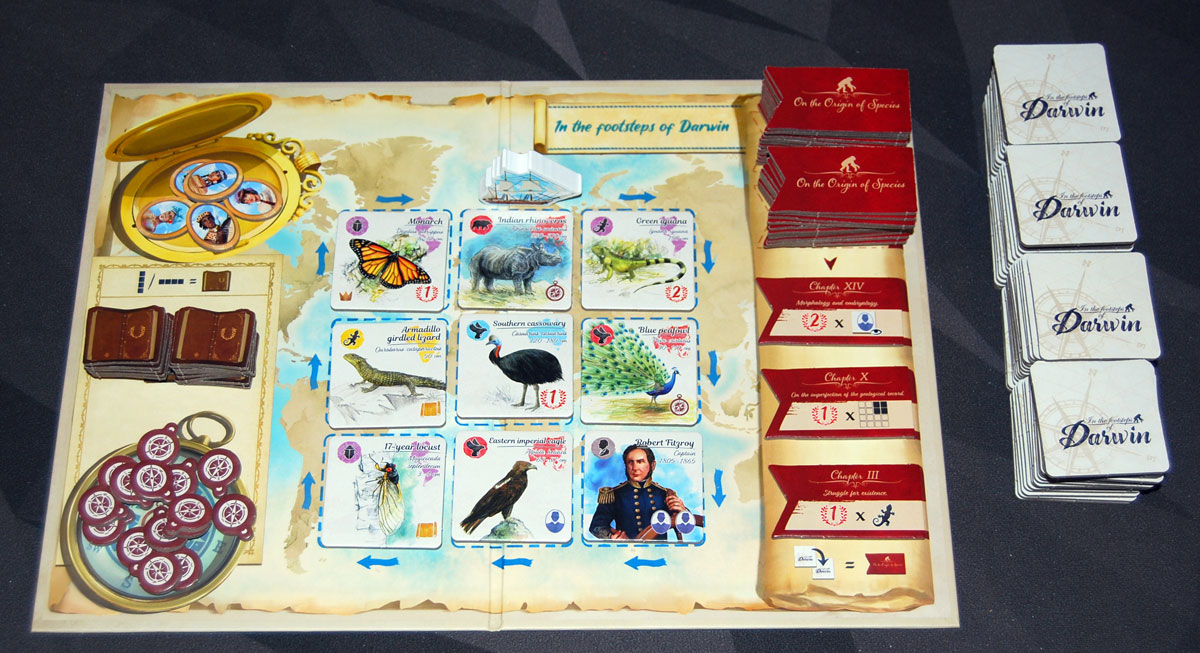
Setup
Shuffle all of the animal and character tiles together, and then make a supply of tiles: there will be 9 placed on the journey board, and then 12 per player in the supply. The rest are returned to the box. Place the Beagle in its starting space at the top center of the grid. Shuffle the theory tiles and place them in two stacks at the top of the journey board, and then reveal three tiles below that. Place the guides, publications, and compass tokens in the spaces on the board.
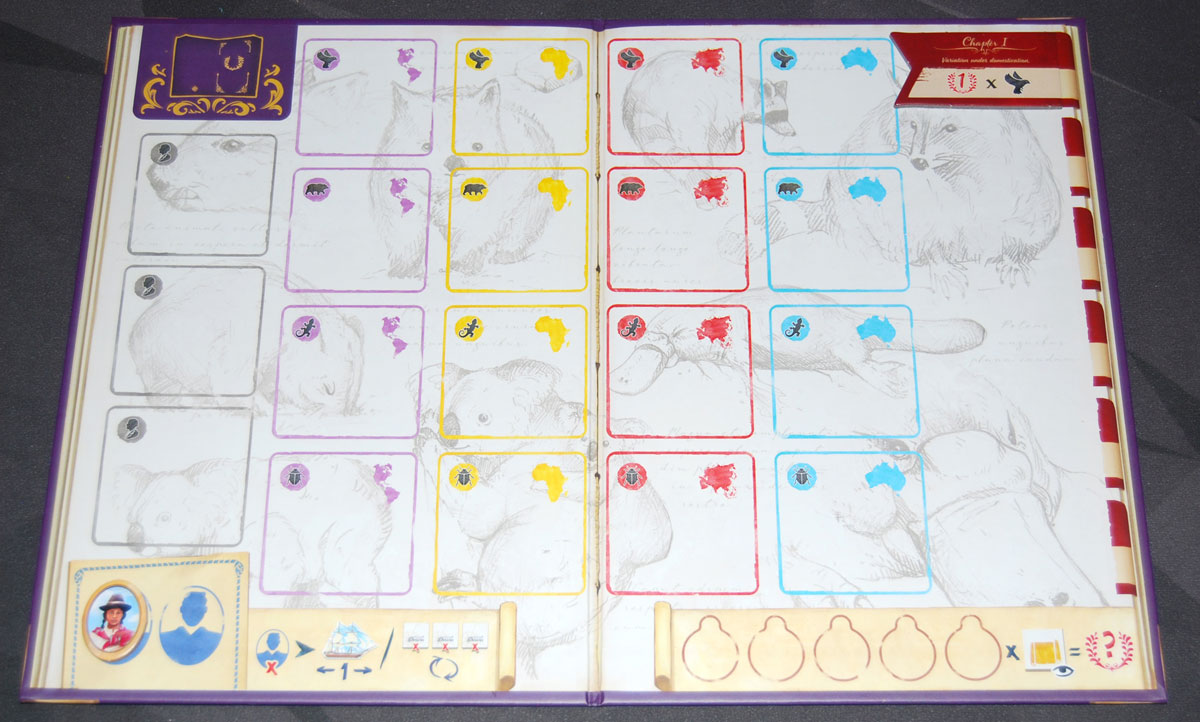
Give each player a naturalist’s notebook, one guide token, and a random theory tile. The player who most recently traveled by ship is the first player and takes the Darwin token.
Gameplay
On your turn, you choose a tile from the board, and then move the Beagle.
You may choose any of the three tiles the Beagle is facing, and place it in your notebook. (For instance, in the setup photo above, I would be able to take any of the tiles in the center column since the Beagle is currently at the top center.) Characters are placed in the spaces on the left, and animals are placed in the large grid in the center: the columns indicate the continent (also distinguished by color) and the rows indicate the animal class.
The icons on the animal token indicate what you get: some have points or charts (which may be worth points later); others may give you a compass, guide, or let you take the Darwin token.
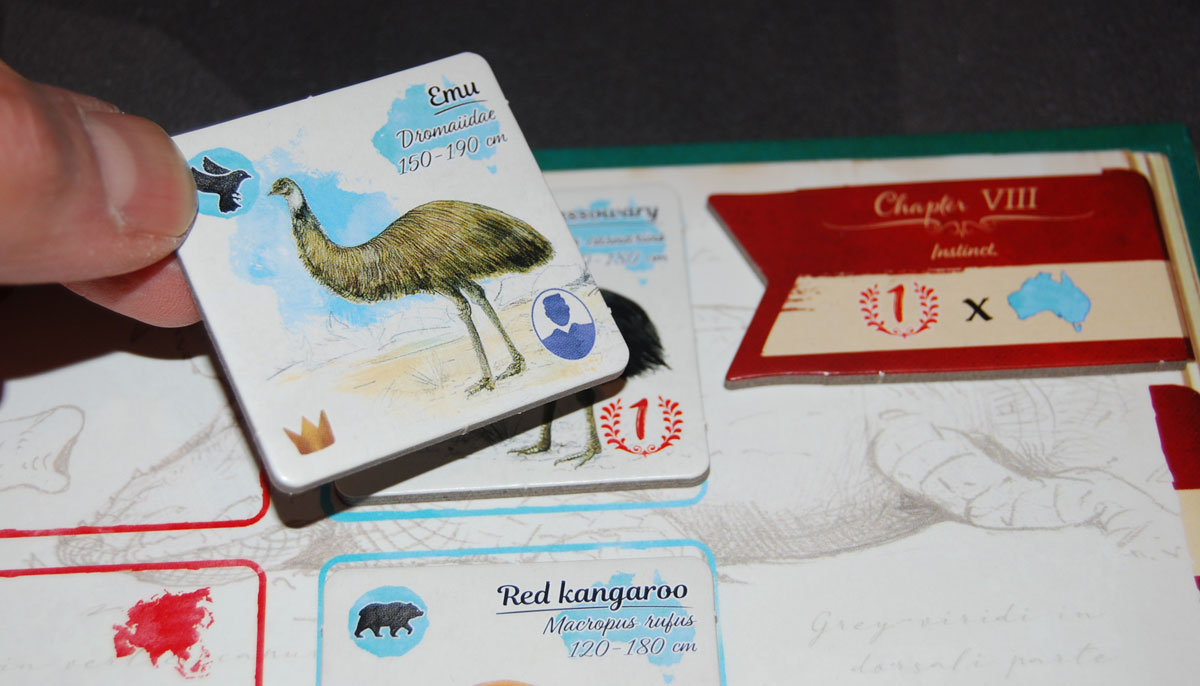
If there’s already a tile in the space where the new animal would go, you just stack on top of it, and then you get to develop a theory. Choose any of the face-up tiles on the journey board, or draw a face-down tile, and add it to your notebook.
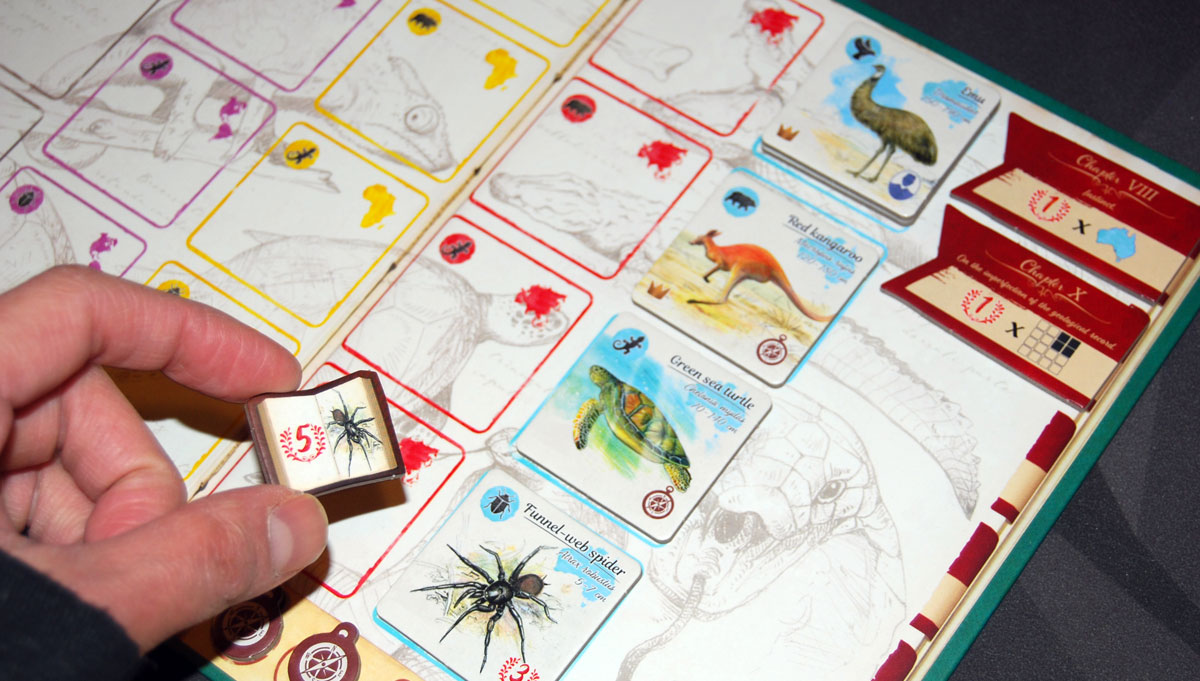
If you complete a row or column in your notebook, you write a publication: take a publication token and place it on notebook.
Finally, at the end of your turn, you move the Beagle clockwise based on which tile you took: if you took the closest tile to the boat, you move 1 space; the center tile, two spaces; the farthest tile, 3 spaces. Refill the board as needed for the next player.
You may have up to 2 guide tokens on your board at a time. Guide tokens may be spent before you choose a tile in two ways: spend a guide to move the Beagle forward or backward one space, or spend a guide to wipe the 3 tiles facing the Beagle (put them at the bottom of the supply stack) and refill the board.
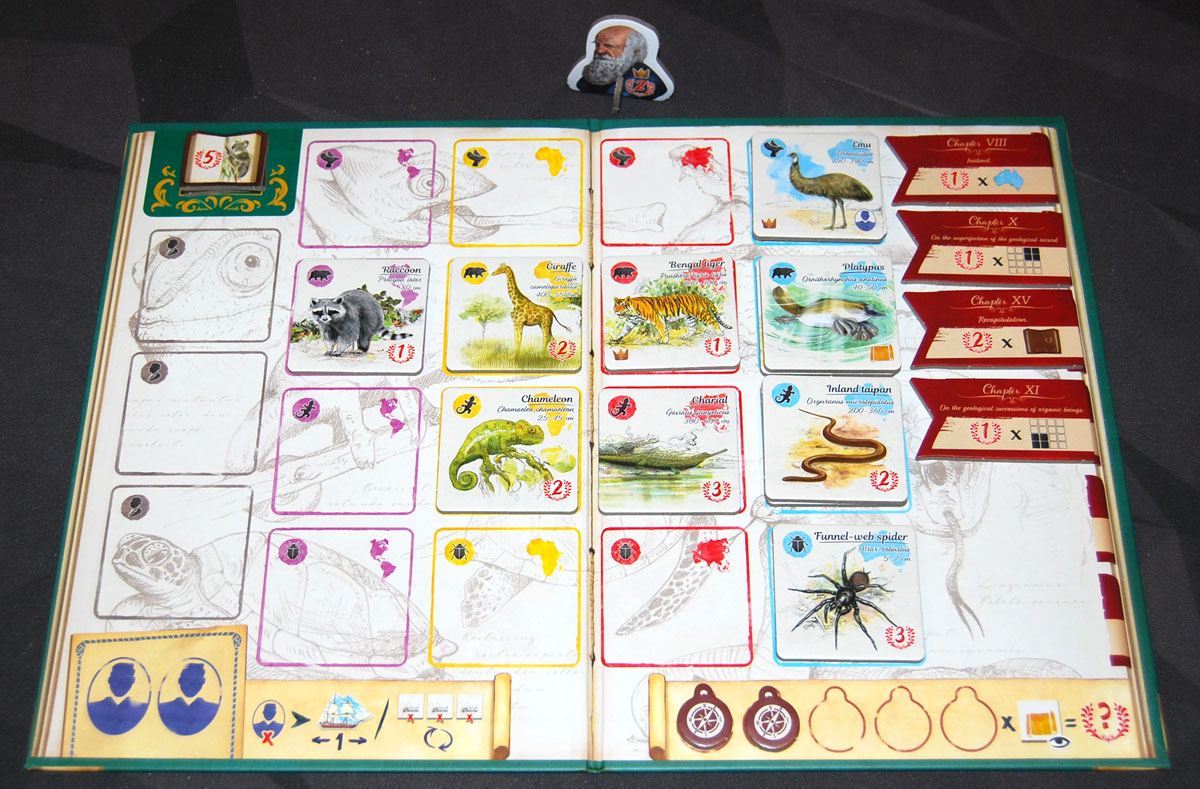
Game End
The game ends when the last tile is placed onto the journey board. Every player will have taken 12 turns.
Score as follows:
- All victory points currently visible on your animals and character tiles
- The number of your visible charts multiplied by the number of your compass tokens
- 5 points per publication
- Points for your theories if you met their requirements
- 2 points for the Darwin token
The highest score wins! Ties go to the player with the most points in theories.
Why You Should Play In the Footsteps of Darwin
In the Footsteps of Darwin is a lovely little game: the animal illustrations and the notebook boards are gorgeous and the attention to detail is excellent. The game is quick—each turn is mostly just choosing a tile to take from one of three options (though using a guide can broaden your choices), and once you’ve chosen a tile it just goes to the designated spot on your board. The only other decision to make is which theory to take if you stack a tile.
But even though the number of options each turn isn’t overwhelming, that doesn’t mean it’s easy to decide! You’ll get twelve turns total over the course of the game, so even if you manage to take entirely unique class-continent combinations, you still won’t fill every row and column. It’s simply impossible. That’s not counting the characters, either, which go in the other three spaces. Filling a row or column gives you a 5-point publication, which seems great. But stacking on top of another animal gives you a theory, which may have a higher potential score, but only if you meet the requirements.
A lot of the theories just direct you to collect a particular type of animal: 1 point per bird, 1 point per Australian animal. Some give you points for tiles in a particular quadrant of your board. You score these points for all tiles that match, even if they’re covered up. But there are others that give you points based on what’s visible by the end of the game: guide icons or crowns, for instance. To maximize those theories, you’ll need breadth instead of depth. The choice between stacking up (for more theories) or spreading out (for more publications) can be hard, and will likely be driven by what’s available when it’s your turn.
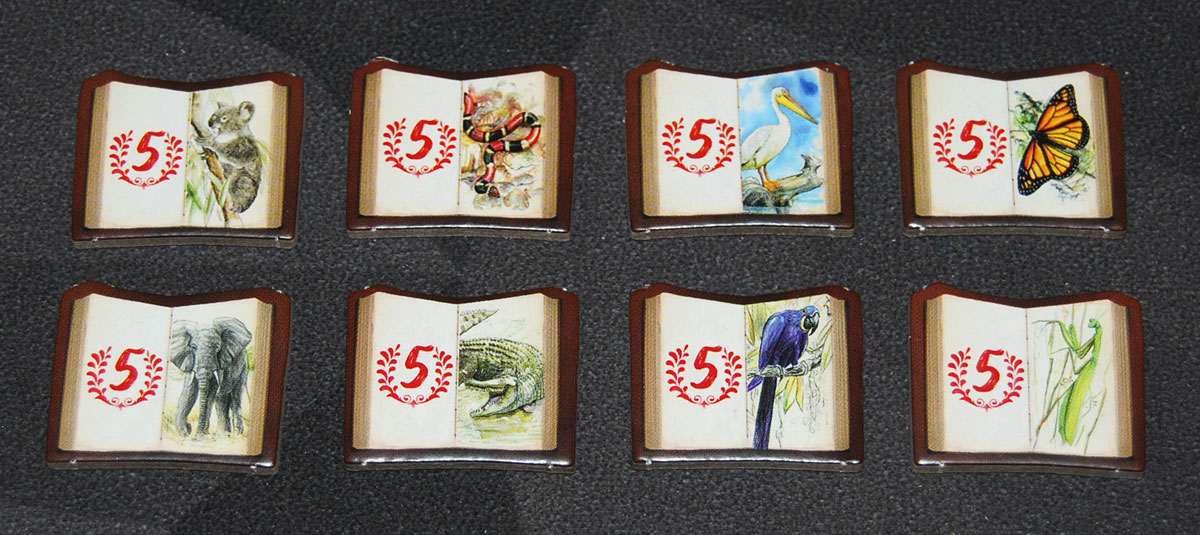
Although you can’t directly affect anyone’s notebook, there’s plenty of indirect ways to interfere with the other players. The simplest, of course, is hate-drafting: taking a tile you know they want. (Though with only 12 turns, it better be useful to you, too!) Where you leave the boat is also important, though. When you’re trying to decide between a couple of pretty similar options, it’s a good idea to consider where the Beagle will end up after your turn, and see if it gives the next player something that helps one of their theories, or works toward a publication. Since all the theories are public information, you have some guesses about what other people want for their own notebooks.
Balancing the types of rewards on the tiles can also be an interesting gamble. Many of the tiles are worth points—up to three for a single tile—but only if they’re still visible by the end of the game. Charts are also only worth points if they’re not covered. But tiles that provide crowns (to steal the Darwin token), compasses, or guides just give you that immediate bonus, and then it doesn’t matter if they’re covered up. Ideally, you want to grab those first, and then stack high-value tiles on top of them to claim theories, but if a 3-point animal is sitting in the market, will it still be there by your next turn if you don’t take it now? Is it worth taking if you’re just going to cover it up later with a compass token tile?
I like the variety of ways you can score points, and the fact that none of them are a sure-fire way to win. The charts-and-compasses can be difficult to optimize, but I’ve seen a player score over half her score by collecting those. Theories can also be quite valuable—you can have up to six theories, but if you don’t find matching tiles they can also be worthless. Publications are a nice middle ground: you’re guaranteed 5 points, but that may or may not help your theories, which usually push you to specialize.
I’ve found In the Footsteps of Darwin to work well with a mix of players—my 10-year-old has been able to join in and play with my adult friends, and though she hasn’t won yet, she still enjoys choosing animals for her board and trying to match up tiles with her theories. For the adults, it’s a fun puzzle to guess which animal or theory will pay off, and also deciding when it’s worth it to use your guides to get some different options. It always feels like it ends a little too soon—but since it’s a fast game, you can easily set up and just play again!
For more about In the Footsteps of Darwin, visit the Sorry We Are French website.
Click here to see all our tabletop game reviews.
![]() To subscribe to GeekDad’s tabletop gaming coverage, please copy this link and add it to your RSS reader.
To subscribe to GeekDad’s tabletop gaming coverage, please copy this link and add it to your RSS reader.
Disclosure: GeekDad received a copy of this game for review purposes.






